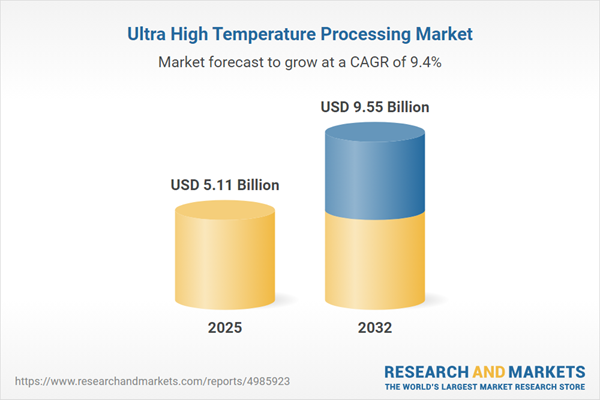Speak directly to the analyst to clarify any post sales queries you may have.
The Ultra High Temperature Processing Market is evolving rapidly, driven by changing food safety requirements and continual industrial advancements. Senior leaders are increasingly looking for insights on the competitive, operational, and regulatory forces shaping the future of shelf-stable dairy and beverage production.
Market Snapshot: Growth Dynamics in Ultra High Temperature Processing
Ultra High Temperature (UHT) processing remains central to food safety innovation, with the market expanding from USD 4.67 billion in 2024 to USD 5.11 billion in 2025. The sector is projected to achieve a CAGR of 9.35%, reaching USD 9.55 billion by 2032. This growth is underpinned by intensified demand for shelf-stable products, ongoing regulatory alignment, and the increasing sophistication of thermal process engineering. Producers worldwide are responding to shifting consumer trends and new compliance mandates, further fueling investments in advanced processing assets.
Scope & Segmentation of the Ultra High Temperature Processing Market
- Equipment: Includes aseptic filling systems, plate heat exchangers, tubular heat exchangers, high pressure homogenizers, ultra high pressure homogenizers, and UHT sterilization systems.
- Product: Covers cream (for coffee and whipping applications), juice (fruit-based and vegetable-based), conventional milk, organic milk, and plant-based beverages (almond, oat, soy).
- Technology: Comprises direct heating and indirect heating solutions, enabling tailored thermal treatments for diverse liquid foods and beverages.
- End User: Encompasses beverage manufacturers, large and small scale dairy plants, and food processing plants.
- Region: Analyzes the Americas (including key North and Latin American markets), Europe, Middle East & Africa (with sub-regional analyses), and Asia-Pacific (focusing on leading nations and emerging hubs).
- Key Companies: Examines strategies and innovations among industry leaders such as Tetra Pak International S.A., GEA Group Aktiengesellschaft, Alfa Laval Corporate AB, SPX Flow, Inc., Krones Aktiengesellschaft, KHS GmbH, John Bean Technologies Corporation, Serac Group SAS, IMA S.p.A., and GEA Procomac S.r.l.
Key Takeaways: Strategic Insights for Senior Decision-Makers
- Continual enhancements in heat exchangers, homogenization, and aseptic filling technology are enabling expanded product portfolios and process efficiency, aligning production capabilities with changing consumer preferences and shelf life requirements.
- Modularity in equipment architectures, such as interchangeable heating modules and scalable filling systems, provides vital operational flexibility to accommodate evolving product lines and mitigate supply chain challenges.
- The rising adoption of digital process controls and predictive maintenance is helping to streamline manufacturing, lower unplanned downtime, and minimize production costs across UHT operations.
- Energy conservation and sustainability measures, including the use of indirect heating and heat recovery, are becoming core differentiators as companies seek to lower their environmental footprint and comply with regulatory expectations.
- Regional market nuances, including investment priorities in North America, specialty dairy trends in Europe, supply chain adaptation in the Middle East & Africa, and rapid expansion in Asia-Pacific, directly affect technology selection, plant configuration, and investment strategies.
Tariff Impact: Navigating U.S. Policy Shifts in 2025
Recent tariff introductions in the United States have altered equipment sourcing strategies within UHT processing. Duties on imported heat exchangers, homogenizers, and sterilization systems are prompting greater reliance on domestic or nearshore suppliers. This shift is influencing vendor partnerships, production scheduling, and lifecycle management, with industry players consolidating orders and extending production runs to optimize costs and operational throughput.
Methodology & Data Sources
This report draws from over fifty primary interviews with manufacturers, executives, and consultants, augmented by secondary research from peer-reviewed journals, regulatory documents, and proprietary industry databases. Data integrity is ensured through multi-stage validation and expert workshops, supporting actionable analysis of both macro trends and operational benchmarks.
Why This Report Matters: Actionable Value for Business Leaders
- Gain clarity on market segmentation, technology adoption, and competitive positioning, enabling confident strategic planning in a rapidly evolving sector.
- Leverage insights on supply chain adaptations and regional variations to mitigate risks and identify new growth opportunities within global UHT processing markets.
Conclusion: Outlook for Ultra High Temperature Processing
Ultra High Temperature processing is shaped by evolving technology, regional drivers, and supply chain dynamics. Decision-makers equipped with advanced market insights will be positioned to capitalize on emerging opportunities and navigate future operational complexities with confidence.
Additional Product Information:
- Purchase of this report includes 1 year online access with quarterly updates.
- This report can be updated on request. Please contact our Customer Experience team using the Ask a Question widget on our website.
Table of Contents
3. Executive Summary
4. Market Overview
7. Cumulative Impact of Artificial Intelligence 2025
Companies Mentioned
The companies profiled in this Ultra High Temperature Processing market report include:- Tetra Pak International S.A.
- GEA Group Aktiengesellschaft
- Alfa Laval Corporate AB
- SPX Flow, Inc.
- Krones Aktiengesellschaft
- KHS GmbH
- John Bean Technologies Corporation
- Serac Group SAS
- IMA S.p.A.
- GEA Procomac S.r.l.
Table Information
| Report Attribute | Details |
|---|---|
| No. of Pages | 189 |
| Published | October 2025 |
| Forecast Period | 2025 - 2032 |
| Estimated Market Value ( USD | $ 5.11 Billion |
| Forecasted Market Value ( USD | $ 9.55 Billion |
| Compound Annual Growth Rate | 9.3% |
| Regions Covered | Global |
| No. of Companies Mentioned | 11 |









